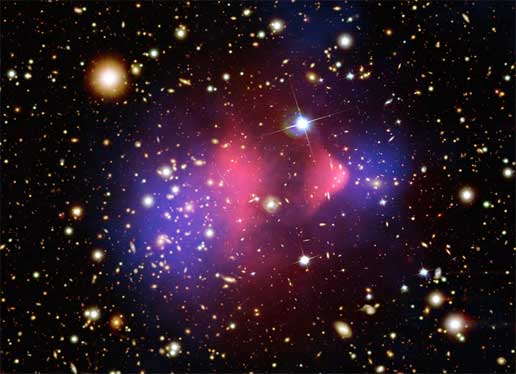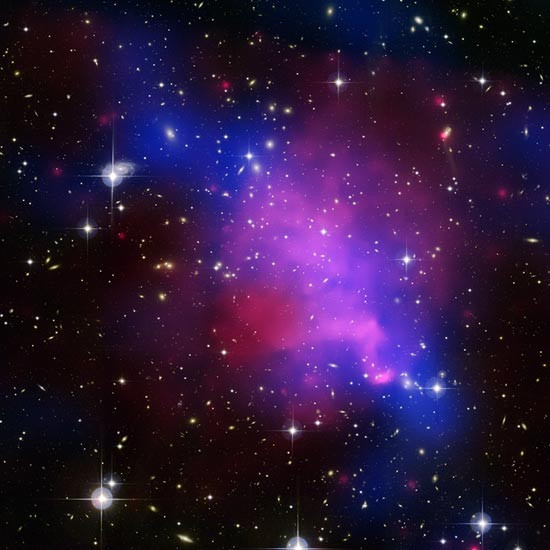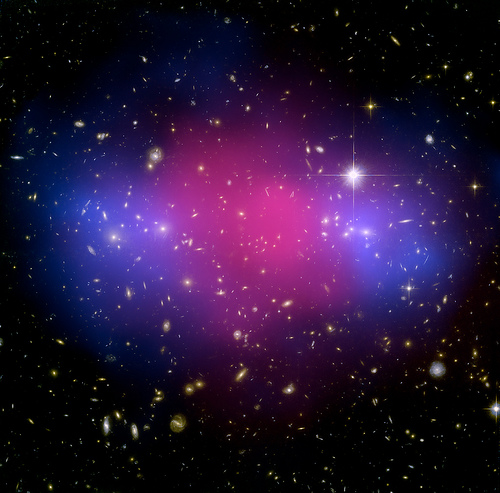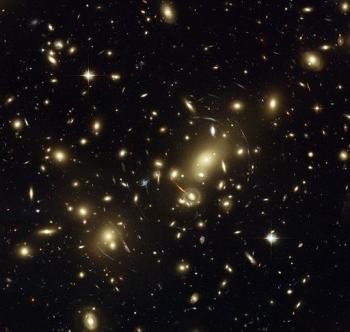I want to thank everyone for their great interest in my last post on dark matter! I got an awful lot of questions about what I mean by dark matter being "collisionless," and in particular, about this picture:

This is two galaxy clusters that have collided recently. The pink shows the X-ray emissions, which comes from the normal matter in the clusters colliding and heating up. The blue shows the mass, and where it is, which I contend needs to be mostly dark matter.
Well, many of you are skeptical, and rightfully so. So I've decided to set you straight, by showing you a visual simulation (that I scavenged) of a pair of colliding galaxy clusters. They contain both collisionless dark matter (in blue) and normal, splat-able matter (in pink). Let's take a look at what happens when we run these into each other (use the control bar and double-click on the image to start/stop the animation):
These theories are called non-local theories of gravity, and you would need a different theory of gravity for every different configuration of colliding galaxy clusters. So you'd need one theory for the bullet cluster (above), another one for Abell 520:

Another one for MACS J0025:

And another one for all the clusters that have not yet collided!

Or, you need dark matter. I'm not going to state that this proves anything, but it, in combination with all the other things that dark matter explains, convinces me. And I hope it helps clear things up for you!

Why do physicists assuming the attractive force attributed to DM must come from gravity?
How is the blue area determined?
Jonathan,
It's the only force we know of that operates on large scales. We observe the motion of stars/galaxies/background light, and then we infer how much matter/energy must be there.
Bjarni,
There's something called "gravitational lensing" that allows us to determine mass. Maybe I should write a separate post on that, too, but the short of it is that background light gets bent depending on how much mass in in-between the light source and us. We observe the light-bending, and then can infer the mass along the line-of-sight. The blue areas are where we see more mass than everywhere else.
Just came from PZ, love the blog!
Good info and animation, helps the understanding.
Will the LHC confirm dark matter? Is the Higgs particle dark matter or something else?
Jonathan,
I thought that dark matter was needed to explain gravitational effects, if we're not attributing gravity to it, then what is responsible? Now we have two mysteries.
Was not DM theorized to explain gravity in the first place, and not the other way around?
The Higgs is a boson and it's normal matter. It's the particle that gives other particles mass and hence is responsible for gravity.
The LHC could confirm either Dark Matter or Superstring theory and as far as I know, if this indeed happens, we can't be sure which one is confirmed :) :).
There's that thing which I think is called "runaway energy" which is the excess energy supposed to be emitted when the collision in the LHC takes place. If after the collision that expected energy is missing, it could be either that it went into the extra tiny dimensions hypothesized by Superstring theory, or it could turn out to confirm dark matter.
If any of the above sounds fishy/untrue, please refer to these two TED videos on dark matter and string theory respectively :), they will explain it far better than I will:
http://www.ted.com/index.php/talks/patricia_burchat_leads_a_search_for_…
http://www.ted.com/index.php/talks/brian_greene_on_string_theory.html
Ethan, looks like people are asking you a lot of questions, I hope you don't mind two more:
1. So is this the reason that something like MOND isn't widely accepted in the physics community. That the geometrical positions of the ordinary matter in various galaxies is such that MOND doesn't work?
2. In your first post on dark matter, you said, "we use telescopes to measure light, which tells us about the amount of normal matter in the Universe, and we also observe the motion of matter to measure gravity, which tells us about the total amount of matter in the Universe" as reasons for Dark Matter. In this post, you've explained why modifying gravity doesn't work, but I wonder if you could explain why modifying light (since that is the other general piece of evidence you give in the quoted part) wouldn't work either?
Personally, I still want to know if he was on gladiators. :)
I'm struggling with this dark/ordinary matter separation thing. Is dark matter somehow separated from the ordinary, or is it mixed up with the ordinary? Do we have dark matter here on earth, contributing to gravity?
I am struck by your willingness to answer questions. I've been trying for many years to get the answer to a non-mathematical question in special relativity, having to do with time dilation. Can you help, either directly or by way of recommending someone who might? I would be happy to pay for the enlightenment. (A personal note; I'm a retired professor of English, living in Mexico.) Regards, Mort Kaplan
Thanks for another great post. In the simulation, the two areas of mass pass through each other without either being deformed by the exchange. Now I realize that DM doesn't interact through anything but gravity, but shouldn't they be sheered by each other's gravitational effects? Similarly, wouldn't DM and LM be mutually attracted? The false colour of Abell 520 looks that way and I surmise that to more trained eyes than mine the others do as well. We are making the assumption that with DM's mass and gravity, it also has momentum, no?
Just on a dumb aside, I was thinking about what a particle like a massive photon might look like. It would have a v
sorry apparently I can't use a less than sign
Just on a dumb aside, I was thinking about what a particle like a massive photon might look like. It would have a v less than c and, given no EM coupling and free from the exclusion principle, would waft around unseen in a very DMish way. But I realize that I don't know if DM CAN be another particle in the normal sense or if there's a compelling reason to say otherwise.
Sorry about all my n00b questions :\
These are all good questions, and by good, I mean they are not all easy to answer.
Since Dark Matter *only* interacts through gravity, we can predict very well what it's going to do. Shear forces are very small, in fact all forces other than that big, Newtonian, F = GmM/r^2 are small, comparatively. That is why we not only expect it to remain two huge blobs (and in this case, we are talking about millions and millions of light years across for each one), when we find that, it's a fairly robust confirmation of dark matter.
Matter particles do what they do because they collide with each other, heating up and emitting light, and therefore they slow down, but the dark matter doesn't.
I was not on gladiators, but if you nominated me and they selected me, I would go.
I know a lot about time dilation -- I can't promise I'll have the answer, but ask away!
Colliding galaxy clusters do, pretty much, kill MOND. Here's why. Picture two big clusters just before a collision and just after. Just before, the dark matter is aligned very well with the normal matter, and so your theory of gravity must tell you that gravity is strongest where all of your normal matter is. Just after the collision, the dark matter is displaced from the normal matter. Meaning that if you don't have dark matter, you need gravity to be strongest where your normal matter isn't, and to be weaker where the matter is.
And we don't modify light because light is one of the few things we understand and observed all the way out to redshifts of z ~ 1100. As opposed to galaxies and clusters, which go out to z ~ 6 at best.
The Higgs is not dark matter, and although it gives particles mass, there was plenty of gravity before there was mass. Remember E=mc^2? Gravity works on energy, not on mass.
That's all for now!
Ethan, this is a great blog. You do a terrific job of explaining large concepts with elegance. (BTW, I'm a different jonathan - note the lower case j, which stands for false modesty.)
I think you could clear up some of the issues by noting that dark matter is a label for the concept and that has both the benefit of bringing in concepts of matter - meaning gravity as a characteristic - and negatives - meaning people think it must be like regular old brick-like matter. As time goes by, we'll figure out more of the substance that goes behind the label, but for now it's very difficult for non-scientists (and even for many of them) to get past the "matter" part of the label. We don't know much of the substance behind the label yet.
It's like if you labeled something "blue" and that wasn't really the color, but represented the idea that it is higher "frequency." People would think the thing is blue.
Thanks for your answers Ethan!
I'm going to press my luck and ask a third question (I feel like Aladdin right now) if that's okay. You mentioned above about the Higgs boson giving particles mass, and then said something about E=mc^2. Does this mean that the Higgs is responsible for giving particles energy as well? That it just sort of gives them this mass-energy content, and then colloquially physicists just say it gives it mass?
Thanks in advance if you can answer that one.
Nope. Back when the Universe was young, mass didn't mean very much, as the kinetic energies of these particles were much greater than their rest mass energies.
So regardless of what the Higgs does today (or whether it even exists!), these particles -- whenever they were created -- had their energy from whatever made them, irrespective of the Higgs.
My problem with dark mass is - why doesn't it clump up? One explanation I got was that it can't shed momentum, so it just keeps flying around. But by that notion, it would fly straight through a black hole, what sounds as far fetched; light can't escape, but dark matter can?
Thanks for the post! Particularly as I was one who specifically requested it.
I can see clearly why you are convinced --- and I am willing to be convinced as well, but my "layman's" eyes (I am a physicist, but in a wholly different field) see three photos with red in the middle and blue on the outside. I hope I'm not being totally dense, but I don't see any obvious differences between the three cases.
Dark mass doesn't clump up because it's so diffuse, and there's no way for it to lose its angular momentum. When DM crosses the event horizon of a black hole, it still gets captured, but if it doesn't, it won't be.
Also, as far as we know, it doesn't interact with things like the Earth and Sun. There's a crazy (but true) theorem that states that if two bodies interact gravitationally and they start out unbound to one another, they will end up unbound. I am trying to get around it by considering 3-body interactions, but that's part of my research work!
And the obvious differences between the three cases are the specific geometries. You need to put in a different (apparently arbitrary) configuration to get the results for each galaxy cluster. Not to mention how different the configurations need to be either significantly earlier or later in the collision.
Hold on, so matter originally had just energy, then at some point the Higgs particle gave it mass? If I've interpreted that correctly, then what exactly is mass? I thought it was just a manifestation of energy, and that due to the history of science and everyday experience, the layman tends to view mass and energy as distinct, when they're really the same thing. Is this wrong?
Why can't electromagnetism explain part or all of the attractive force attributed to DM? 98% of the matter in the Universe is hydrogen. 98% of mater in the Universe is plasma. That means the vast majority of matter in the Universe (~96%) is hydrogen plasma. Hydrogen plasma is highly conductive. When conductors are rotated against each other, the generate electric current. Electric currents generate magnetic fields. You can propagate a magnetic field by using a conductive medium as an intermediate. Like waving a bar magnet over a pile of paper clips, it only works close up. However, if you attach a paper clip to the magnet, you can daisy-chain them out to a much farther reach. This effect is at work in the magnetosphere of Jupiter. Ions from Io allow the Jovian magnetosphere to expand greatly.
Stars are spinning balls of plasma that have massive magnetic fields. They also kick off large amounts of hydrogen and helium ions, forming a soup of ions in interstellar space (though this soup is significantly less dense in our stellar neighborhood). Also, the stars in a galaxy are all oriented in the same direction; thought to be due to the action of super-massive black holes in the formation of galaxies (though, again, our own star is oddly out of alignment). This allows the magnetics fields off all the stars to propagate throughout the galaxy in a mostly coherent manner. The galaxies themselves are spinning plates of plasma, and if they had a coherent magnetic field, qould be able to propagate that field just like the stars do to form super-clusters.
Considering electromagnetism is literally a billion, billion, billion, billion times stronger than gravity, it could suffer attenuation of 10^35 and still account for all the attraction attributed to DM.
Jonathan, surely the problem with that idea is that while stars are made of plasma, said plasma is electrically neutral overall surely? Plasma is after all just a bunch of protons and electrons with the electrons having originally been stripped from the protons i.e. there is the same number of protons as electrons.
plasma, said plasma is electrically neutral overall surely? Plasma is after all just a bunch of protons and electrons with the electrons having originally been stripped from the protons i.e. there is the same number of protons as electrons.
AFAIK, there doesn't need to be the same number of protons as there are electrons. I do believe is has to do with the symetry breaking effect of the weak nuclear force. Putting that aside from now, plasma is not naked protons, except in the case of protium plasma. Matter enters a plasma state when it sheds it's outer shell of electrons. While in period I that leaves the nucleus bare, as period I elements only have one electron shell. All other elements retain most of their electrons. Because helium, tritium, and deuterium all have neutrons, the lack of neutrons and electrons make hydrogen the best non-superconducting conductor around. The electrons in a protium plasma can stay with the plasma or go flying off into space. If they remain with the neuclei, they do not enter orbit in an electron shell, but they will be attracted to the positively charges protons. This is why its so conductive.
When exposed to a rotating magnetic field, those electrons would generate a current through the plasma, which in turn generates a magnetic field. This is exactly what my hypothesis rested on, so no, it doesn't contradict my hypothesis. Now, the question is how far the magnetic field can reach. My hypothesis was that, because so much of the matter in the Universe is hydrogen (~98%), and most of that hydrogen is protium (again ~98%), and most of that protium in in a plasma state (yep, you gussed it, ~98%), and its all spinning in a mostly alligned fashion (98%), that the field could propigate through the interstellar and intergalactic mediums for large distances. Now most of the unified field would be neutralized by small perturbations in the stars, the intergalactic medium, and intersellar winds (~99.9999999999999999999999999999999999%). However, because electromagentism is far stronger than gravity (10^36 times more powerful) that 0.00000000000000000000000000000000001% is still ten times more powerful than all the gravity from visible matter (15% of the observed attractive force in the Universe) making it theoretically possible that DM does not exist.
Jonathan,
As a theoretical astrophysicist -- one who's worked in the field of astrophysical plamsas and their cosmological consequences (check it out) -- I know the answer to this question.
We know how powerful the magnetic fields of structures like galaxies and clusters are. We know the forces with which they interact. We can compute how important these effects are compared to gravity, and they are -- at most -- about 10^-5 times as strong as gravity. You are forgetting that the distances here are very large, and that gravity falls off by 1/r^2 while magnetism (a dipole force) falls off as 1/r^3. Additionally, we know the electric neutrality of the Universe to one part in 10^39 or so, as references in my paper above. So what you're saying is possible in principle, but it doesn't occur in our Universe.
Jonathan,
As a theoretical astrophysicist -- one who's worked in the field of astrophysical plamsas and their cosmological consequences (check it out) -- I know the answer to this question.
We know how powerful the magnetic fields of structures like galaxies and clusters are. We know the forces with which they interact. We can compute how important these effects are compared to gravity, and they are -- at most -- about 10^-5 times as strong as gravity. You are forgetting that the distances here are very large, and that gravity falls off by 1/r^2 while magnetism (a dipole force) falls off as 1/r^3. Additionally, we know the electric neutrality of the Universe to one part in 10^39 or so, as references in my paper above. So what you're saying is possible in principle, but it doesn't occur in our Universe.